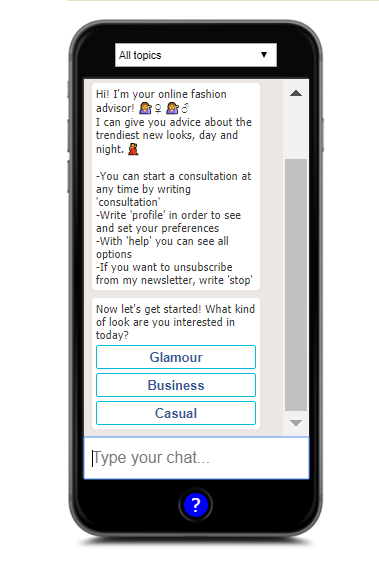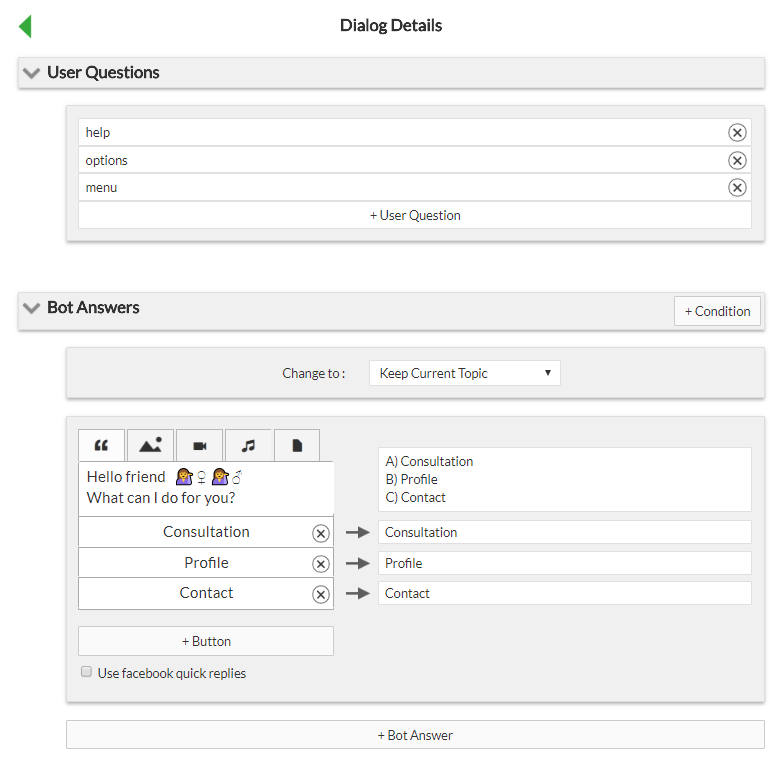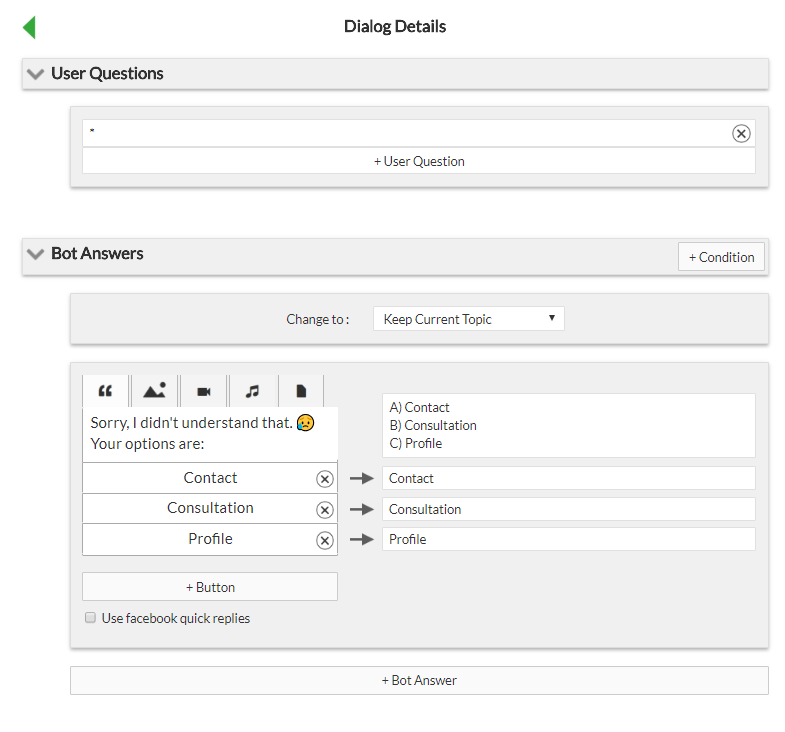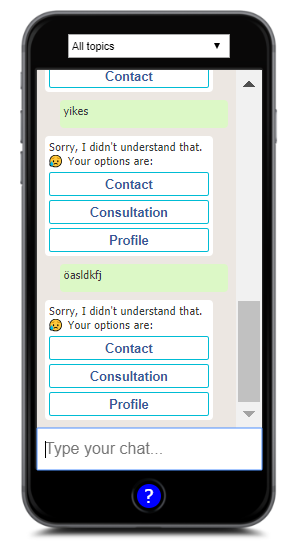Of course, you immediately want to start building Chatbots! If you want your Bot to be successful, take your time to think about a couple of things first.
Here are a couple of questions you should ask when conceptualizing your chatbot:
- What is the goal for my Chatbot?
- What is the target group for my Chatbot?
- What platforms should my Bot work with?
- In what language should I offer my Chatbot?
- What kind of communication style should my Chatbot have?
- How can I measure my Bot’s success?
- How should my Chatbot guide the user through the conversation?
-
- Personal greeting
- Help
- Unrecognized user input
8. How can I make my Chatbot as user-friendly as possible?
Chatbot goal
Everyone needs a goal in life — including Chatbots! A Chatbot without a clearly defined purpose can’t help anyone. The first thing you should decide is what tasks your Chatbot will have.
There’s a wide variety of possible Chatbot objectives. There are important business goals like “improve customer satisfaction” or practical goals for simple problems like “FAQ Bot: should answer frequently asked questions.”
It’s possible for your Chatbot to have several goals, but you should make sure the focus stays clear, so that the Chatbot conversation structure doesn’t become confusing.
We suggest to use the Minimum Lovable Product strategy: start small, and offer your users a Chatbot that works so well that your customers immediately see the value in it. Once your Bot is successful, you can continue developing its’ range.
Here are some possible Chatbot types for inspiration:
- AdviserBot: advises customers about products and services
- RecruitingBot: advertises the company to potential employees
- ServiceBot: helps with customer service
- OnboardingBot: answers questions from new employees
Target Group
Who should your Bot help? Who is your target group? Is it for employees, or partners, or clients — for potential customers, the press, investors, marketers? Who should your Chatbot prepare information for?
Target Platforms
What platforms should I offer my Bot on to effectively reach my target group? MessengerPeople currently supports the following messanging apps:
- Facebook Messenger
- iMessage
- Telegram
- Notify
Depending on the demographics (age, income) or geographic characteristics of your target group, different messengers may provide different advantages. In the USA, for example, Facebook Messenger is used widely, whereas WhatsApp is strong in Europe, India, and Brazil.
Languages, Brands, and Markets
What language should my Bot speak and what markets do I want to offer my Chatbot services in? This question is specifically important for bigger companies. It’s possible that you want to offer the exact same Chatbot in five different languages.
Depending on the company structure, the following questions could be considered:
- What brands should we offer the Chatbot for?
- Do we want a global Bot for the whole company, or should there be a different Chatbot for each country/region/location/department?
Communication Style
Your Chatbot should represent your company, so the Chatbot needs to be able to express itself properly. If you’re a young, cool business with a trendy target group, then you should stick to a relaxed, modern tone. If your business is more serious and dignified, then your Chatbot should speak more formally.
In general, it’s safe to say that emojis, pictures, videos, and audio messages significantly improve the user experience and make the dialogue more interesting. You know how it goes…a picture says a thousand words. Graphics are often easier to understand quickly than texts. But you should use media sparingly, and not bombard your users with too much of a good thing
Measuring Success
How can I measure my Chatbot’s success? Depending on the Chatbot objectives, a variety of different methods can provide insights on how your Chatbot is fulfilling its goals. Here are some examples:
- Generating data/leads: conversation rate
- Generating orders: conversion rate
- Improving customer satisfaction: feedback
Personal greeting and introduction
The greeting is an extremely important moment in the interaction with a Chatbot. It’s important to clarify the basics for the user, right at the beginning: what the bot is here for (the goal), what it can help you with (task), and how a user can use it (guidance).
Support
You can use keywords to give the Chatbot user the opportunity to break off the conversation, restart, or get help. When the user hasn’t used the Bot in a while, then it’s possible that the user has forgotten which specific keywords the Bot uses and just writes ‘menu’ or ‘help.’ The Bot should be able to respond to this.
It’s easy to create a help dialogue in the Chatbot Builder!
Dialogue Problems
It makes sense to set an answer that the Bot automatically says when it doesn’t understand the user input, or when it doesn’t find a match between the user input and the preset dialogues.
For these situations, there’s a specific syntax that you can use in the Chatbot Builder: the asterisk!
Create a new dialogue and enter the user input as: *
The Bot answer can be something like:
Sorry, I didn’t understand that
Your options are:
A > advice
P > profile
C > contact
Create the asterisk dialogue thoughtfully, because the Bot will use this answer react to everything that the user writes, if it finds no other matching dialogue.
Navigation Structure
Here you should decide what kind of topics the Bot should handle, and whether or not these need to be hierarchically ordered. Then you can decide what the most user-friendly customer journey is: how would a user intuitively move from theme to theme?
When building the navigation structure, a visual representation can be helpful. Start with a basic topic collection, which you can then place in a structure and a sequence. You can draw the whole thing, work with post its and flipcharts, use digital tools like PowerPoint or Mindmaps, or use a professional chatbot tool like Botsociety. A very handy tool we can recommend is draw.io.
When creating a structure in the Chatbot Builder, you should pay attention to the following things:
- You need a dialogue for each menu option
- This dialogue can process the user input and jump to the appropriate follow-up topics
- On Facebook/Telegram, a menu is best made with Buttons
- On WhatsApp and Notify, a menu is best made with an A, B, C selection: A for glamour, B for Business, C for casual
- On iMessage you can use ListPicker for menu-options
- Themes can be reached from different spots in the conversation
- Because of this, the entry sentence for different topics must be context neutral
- After a quick introductory sentence, menu options follow
- Each function block requires a topic






